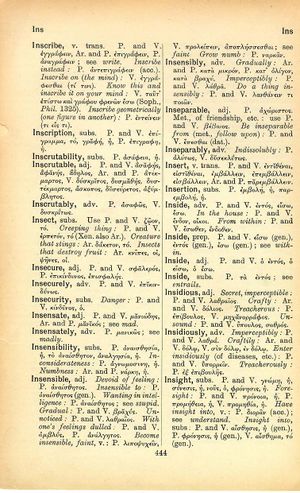inscribe: Difference between revisions
From LSJ
Οὐκ ἔστι σιγᾶν αἰσχρόν, ἀλλ' εἰκῆ λαλεῖν → Silere non est turpe, sed frustra loqui → nicht Schweigen schändet, sondern Schwätzen auf gut Glück
(Woodhouse 3) |
(CSV4) |
||
| Line 1: | Line 1: | ||
{{ | {{Woodhouse1 | ||
| | |Text=[[File:woodhouse_444.jpg|thumb|link={{filepath:woodhouse_444.jpg}}]]'''v. trans.''' | ||
P. and V. ἐγγράφειν, Ar. and P. ἐπιγράφειν, P. ἀναγράφειν; see [[write]]. | |||
<b class="b2">Inscribe instead</b>: P. ἀντεπιγράφειν (acc.). | |||
<b class="b2">Inscribe on</b> (<b class="b2">the mind</b>): V. ἐγγράφεσθαι (τί τινι). | |||
<b class="b2">Know this and inscribe it on your mind</b>: V. ταῦτʼ ἐπίστω καὶ γράφου φρενῶν ἔσω (Soph., ''Phil.'' 1325). | |||
<b class="b2">Inscribe geometrically</b> (<b class="b2">one figure in another</b>): P. ἐντείνειν (τι εἴς τι). | |||
}} | }} | ||
Revision as of 09:44, 21 July 2017
English > Greek (Woodhouse)
v. trans.
P. and V. ἐγγράφειν, Ar. and P. ἐπιγράφειν, P. ἀναγράφειν; see write. Inscribe instead: P. ἀντεπιγράφειν (acc.). Inscribe on (the mind): V. ἐγγράφεσθαι (τί τινι). Know this and inscribe it on your mind: V. ταῦτʼ ἐπίστω καὶ γράφου φρενῶν ἔσω (Soph., Phil. 1325). Inscribe geometrically (one figure in another): P. ἐντείνειν (τι εἴς τι).

